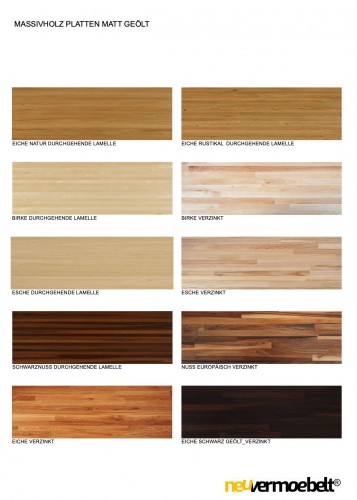Sie haben noch keine Artikel im Warenkorb.
SOLID WOOD WORKTOPS
There are many advantages of solid wood worktops in the kitchen. Here are some of them:
-
Natural and warm look: Wooden worktops give the kitchen a natural and warm atmosphere. The natural pattern and texture of the wood brings an organic beauty to the space and gives it an inviting charm.
-
Versatility: Wood worktops are available in a variety of wood types and shades, so you can find an option that suits your individual style and design preferences. Whether you have a rustic, modern or traditional kitchen, there are a variety of wood types and finishes to choose from.
-
Durability: Wood is a robust material that has good durability. With the right care and regular maintenance, wooden worktops can last for many years and even develop a beautiful patina over time.
-
Worker-friendliness: Wooden worktops provide a comfortable work surface when cutting, preparing and cooking. Compared to hard materials such as granite or stone, wooden worktops are gentler on knife blades and gentle on crockery if it is accidentally dropped on them.
-
Sustainability: Wood is a renewable resource that is a sustainable option when managed responsibly. By buying wooden worktops from certified and sustainably managed sources, you are helping to protect forests and reduce your carbon footprint.
Wooden panels are robust, can be repaired and easily refurbished if the surface is damaged. Since wood can absorb both moisture and heat, they help improve the indoor climate. In addition, wood has an antibacterial effect.
Correctly clean and maintain oiled solid wood worktops.
It is important to note that wooden worktops require some care to maintain their beauty and durability. They should be treated regularly with special wood oils or waxes to protect them from moisture and stains. In addition, hot pans or pots should not be placed directly on the wooden surface to avoid burns or discolouration.
Stain prevention
In order to enjoy your oiled wooden tops for a long time, you should take care not to allow dirt to build up in the first place. Bottles and glasses on which drops of liquid can form should only be placed on the boards with coasters. Direct sunlight can cause wood to darken. If discolouration does occur, the area in question can be sanded down and re-oiled. In general, dirt should be removed immediately so that it does not become a problem in the first place.
Clean and care for wooden furniture correctly
But despite the protective oil layer, the wooden panels are not completely protected from dirt and signs of wear. This is where the right care is crucial.
Light dirt and minor stains can usually be removed with a damp, dry cloth. Then wipe with a dry cloth to make sure that the furniture is really dry.
Cloths made of cotton, linen, cellulose or microfibre cloths are suitable for cleaning. Microfibre cloths, however, can leave scratches in the surface due to their abrasive effect. If the cloth is rubbed too hard over the surface, unattractive colour differences may appear on the wood. For this reason, it is important to test the stain on an inconspicuous area before rubbing the visible surface. If the stain cannot be removed in this way, pH-neutral cleaners can be used. The detergent should be used in low doses. Heavy soiling, dents or scratches can be sanded off and resealed with a new layer of oil. It is better to remove dust with a feather duster or duster cloth.
mit Öl behandeln
Zum Schutz des Holzes wird die Oberfläche mit Öl behandelt, dadurch wird das Holz wasserabweisend und gegen Schmutz geschützt. Hartöl hat gegenüber Lack den Vorteil, dass es in das Holz einzieht. Bei hoher mechanischer Belastung kann eine Lackschicht abgetragen werden, bei geölten Oberflächen bleibt der Schutz erhalten. Durch das Öl erhält die Oberfläche einen seidenmatten Glanz, die natürliche Haptik des Holzes bleibt bestehen.
Bereits geölte Stücke können erneut aufgefrischt werden.
Dafür einfach die Oberfläche des Möbelstücks reinigen und abschleifen. Geschliffen wird in Faserrichtung. Für den letzten Schleifgang sollte Schleifpapier mit einer sehr feinen Körnung verwendet werden, um eine glatte Oberfläche zu erzielen.
Vor dem Ölen muss der Schleifstaub gründlich von der Oberfläche beseitigt werden. Das Öl kann mit einer Lackrolle oder einem weichen Tuch verteilt werden, bis die Oberfläche leicht feucht aussieht. Nun das Öl etwa eine Viertelstunde einziehen lassen und Überschüsse abwischen. Die Platte über Nacht trocknen lassen und den Vorgang am nächsten Tag wiederholen. Um den Schutz zu erhalten, sollte man seinen Holzplatten ein- bis zweimal pro Jahr eine neue Ölschicht gönnen.
Empfehlenswert ist das Öl welches wir benutzen.

